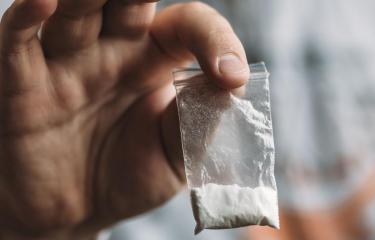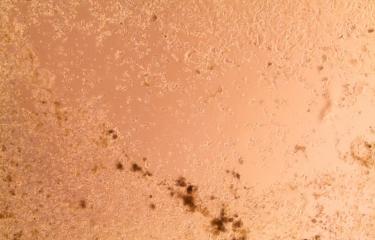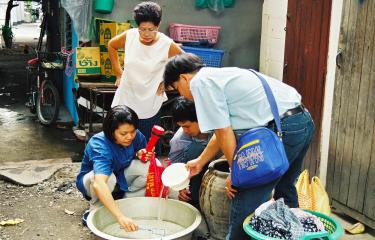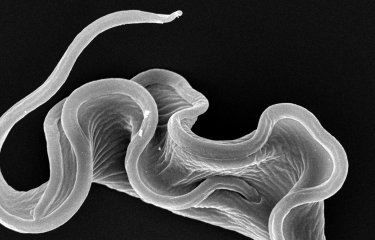At an international conference organized jointly by the Mirror Biology Dialogues Foundation (MBDF) with the Institut Pasteur on June 12 and 13, 2025, scientists and ethicists from around the world shared their views on the risks and challenges of "mirror life." This new frontier in synthetic biology raises the possibility of creating organisms in the laboratory that would be chemical mirror images of known living beings. It is a future scientific prospect that has multiple ethical and societal implications and raises questions about our collective responsibility.
On June 12-13, 2025, the Institut Pasteur hosted the first international conference on the risks and challenges associated with the creation of what are known as "mirror microorganisms." Some of the molecules in the living world have a strict asymmetry that is always the same. Many biological molecules, especially DNA, RNA and proteins, can exist in two different mirror forms. In general, only one of the two forms exists in nature, but the mirror image can be built in the laboratory. If one day we manage to create "mirror microorganisms," it would represent a serious threat to the environment and to public health – hence the need for transparent scientific discussion and considered ethical reflection to develop a potential international regulatory framework.
The conference involved two parts.
- June 12, 2025: a symposium to encourage discussion. This was a time for explanations and transparent debate, during which scientists, ethicists and institutional decision-makers examined the latest knowledge, prospects for development and societal issues raised by the rapid progress in synthetic biology.
- June 13, 2025: an opportunity for scientific reflection. This involved a series of workshops where invited experts could engage in scientific discussions. Nearly a hundred experts in synthetic biology, immunology, ecology and bioethics, as well as political decision-makers and funders, came together to discuss the risks and advantages of mirror life and to start considering how the risks might be mitigated.
At the conference, the scientists and ethicists were of the view that mirror life poses significant risks and only limited benefits, leading to the conclusion that mirror organisms should not be created.
See the press release written by the MBDF, which outlines some of the discussions at the conference in June 2025.
"Research to create mirror life should not be pursued. What could be more fitting than to reach such an important determination here in Paris, where Pasteur himself discovered the role of chirality in biology," emphasized Margaret Buckingham, Chair of the Institut Pasteur Ethics Committee. It was in 1847, at the École normale supérieure, that Louis Pasteur discovered chirality, a property of biological molecules which means that they cannot be superposed on their mirror image, like our two hands.
A report on the conference will be produced over the coming months, with recommendations for the path forward.
The Paris conference was the first in a series of meetings, with future events set to be held in Manchester and Singapore.
Summary of questions covered :
- Introduction: What is “mirror life”?
- Why is there an interest in mirror life today?
- Mirror organisms: what are the potential risksfor human health?
- How could mirror life represent a threat to the environment?
- Could there be any positive reasons to pursue mirror biology? Maybe to create mirror molecules, rather than entire organisms?
- Why have scientists suddenly decided to address the risks of mirror life now, in 2025?
- Is there really any reason to study mirror organisms?
- What steps would need to be taken before mirror microorganisms could start to be produced in the laboratory, and what are the implications?
- Conclusion : What did the experts agree on at the end of the “Mirroir Life” conference in Paris?
What is "mirror life"?
"Mirror life" refers to a form of life in which biological molecules, such as those that make up cells, are the mirror image of those found in all organisms on Earth. Chemists would say that "their structure exhibits the opposite chirality to that found in nature."
This molecular dissymmetry is a concept discovered by Louis Pasteur in 1847 when he was studying the crystals of compounds known as tartrates. He observed that some of these crystals existed in two symmetrical forms, and that each form had distinct physical properties. Pasteur first revealed the concept of chirality (also known as "handedness") the following year, in 1848, when, aged just 26, he gave a demonstration to his professor Jean-Baptiste Biot shortly after completing his PhD in Science.
The concept, named by Lord Kelvin some decades after Pasteur's discovery, describes the property of some molecules that cannot be superposed on their mirror image – like a person's hands, which look alike but cannot be superposed one on top of the other. In the same way, some molecules exist in two symmetrical forms that cannot be superposed, even though they are chemically identical. All living beings have "left-handed" amino acids (labeled L in chemistry) and "right-handed" sugars (labeled D). But a mirror life would build proteins from right-handed amino acids and left-handed sugars, meaning that its DNA would be the reverse of the DNA we know.
In biological terms, this complete reversal would lead to organisms with metabolic properties that also perfectly mirror those found in naturally occurring organisms.
Some scientists, like David Bikard, Head of the Synthetic Biology Unit at the Institut Pasteur, believe that this form of life could have existed in the "primordial soup" of ancient Earth, which is presumed to have contained molecules from both sides of the mirror. If so, it is likely to have disappeared more than three billion years ago, leaving us with the single chirality that we know today.
Currently no form of mirror organism is naturally present on Earth, but we can now envisage the technical possibility that such an organism might be artificially created in a laboratory one day.
Why is there an interest in mirror life today?
From the 1970s, when the concept of chirality in chemistry became more widely known, until recently, mirror life was primarily a theoretical concept, but rapid progress in synthetic biology, genetics and chemistry has propelled it to the forefront of discussions. As researcher Filippa Lentzos, Associate Professor in Science and International Security at King's College London, said at the Mirror Life symposium on June 12, 2025 at the Institut Pasteur, "We are in a genuine 'window of opportunity' to limit the risks of creating a mirror bacterium before it becomes technically feasible." The mere possibility that it might one day be possible to create mirror life is leading the scientific community to anticipate the potential implications. What might it be used for, what environmental risks would it pose, and how could we legally and ethically regulate innovations in this area?
We are still far from such a breakthrough, and it would require considerable investment. However, we are already able to produce reverse chirality versions of certain nucleic acids and proteins in the laboratory.
This progress is recognized as opening up positive avenues, such as the discovery of novel applications in medicine or biotechnology (see also question 5), but it also raises questions, especially about the ethical risks. Even if we were able to engineer an entire mirror microorganism, there would still be many challenges to overcome. As John Glass – a professor, leader of the Synthetic Biology Group and Campus Director at the J. Craig Venter Institute – points out, no laboratory has yet been able to recreate a mirror version of cytosol, the fluid inside cells where vital cellular reactions take place, or a synthetic ribosome. This represents a major obstacle.
All these questions were discussed at the international conference held at the Institut Pasteur to draw the attention of scientists, policymakers and civil society to these new challenges.
Mirror organisms: what are the potential risks for human health?
Mirror bacteria could pose unprecedented health risks. Because their chemical makeup would be reversed, their molecular structure would be completely different from that of the organisms known to our body. Our immune system, which is only able to recognize and tackle pathogens with natural chirality, would likely be incapable of detecting or neutralizing an infection caused by mirror bacteria. They could therefore develop unhindered, triggering little or no immune response.
Most current antibiotics and treatments have been designed to target pathogens in their natural conformation, so they would be ineffective against pathogens with reverse chirality. These mirror bacteria could therefore lead to novel diseases that would be untreatable with current methods. A well-known example highlighting how mirror molecules do not interact in the same way with natural-chirality life is Thalidomide. This sedative drug was brought to market in the 1950s but soon withdrawn from sale. Its composition contained both the active molecule and its mirror version, which was highly teratogenic, leading to 10,000 infants being born with malformations.
Some experts, like Deepa Agashe, Associate Professor at the National Center for Biological Sciences in India, warn that such life forms could affect not just humans but also animals, plants and other forms of life, and that their potential for propagation is hard to predict. And if mirror microorganisms were viable, they would be adaptable and could adopt resistance and evolution mechanisms similar to those observed in known microbes, adding an additional difficulty to the challenge of controlling potential disease outbreaks.
"The data that we currently have indicate that a mirror bacterium could survive in our environment, but the question merits further exploration. It may be that our environment would be toxic for mirror bacteria," says David Bikard.
How could mirror life represent a threat to the environment?
If laboratory-created mirror organisms were introduced in nature, either by accident or deliberately, they could severely disrupt ecosystems. Their reverse chemistry would make them incompatible with an environment governed by natural chirality: most predators competitors or natural defenses would incapable of effectively regulating them.
They could find unoccupied ecological niches or colonize environments to the detriment of existing species, infecting plants, animals or microorganisms.
John Glass stresses that when handling this type of organism, even the most stringent biosafety standards (level 4, the highest) would be too risky – if just a single mirror bacterium were to be accidentally released into the environment, the situation could become impossible to control. Even the slightest laboratory error could have irreversible repercussions, since we currently have no effective natural or chemical defenses.
Could there be any positive reasons to pursue mirror biology? Maybe to create mirror molecules, rather than entire organisms?
Yes, the creation of mirror molecules could have benefits, especially in the fields of research and medicine. Compounds such as Degarelix and Difelikefalin, essentially composed of mirror amino acids, are already available on the market. Other applications are currently being explored (for example peptides synthesized using a mirror enzyme) to develop more resistant drugs, which unlike natural molecules are almost completely impervious to destruction by the body's enzymes. This could pave the way for more stable, effective treatments. But these molecules can already be produced now using chemical synthesis methods, without the need to create entire mirror organisms.
Why have scientists suddenly decided to address the risks of mirror life now, in 2025?
Since the call by a group of 38 leading scientists in the journal Science in December 2024, the question of the risks posed by the emergence of mirror microorganisms has received global attention. The authors, whose initiative was widely reported in the media (including Le Monde), are calling for a broader conversation among the scientific community and for an organized forum for collective reflection on the prospects and potential dangers of these new life forms.
The scientists are currently focusing on understanding and assessing the scale of the risks and challenges in scientific terms. It is not the first time scientists have come together to discuss a pressing issue: back in 1975 at the Asilomar Conference, biologists gathered to set standards for research on recombinant DNA, another field that at the time was believed to represent a risk for society.
On the question of mirror life, the initiative will involve a series of international meetings, the first of which was the conference in June 2025 at the Institut Pasteur. The aim of the discussions was to clarify the scientific and ethical considerations, while starting to reflect on ways in which the risks could be mitigated. The conference in Paris lays the ground for the events set to be held in Manchester and Singapore over the coming year. As the neurobiologist and Chair of the Inserm Ethics Committee Hervé Chneiweiss explained on the radio station France Inter, this is "the second major instance of self-regulation by the scientific community." But the discussions must go hand in hand with the development of a robust, transparent institutional and regulatory framework, and civil society must be involved. The aim is to prevent important decisions being taken only by a small group and to foster collective responsibility. Many scientists argue that self-regulation is not enough and are calling for a more formal regulatory approach.
Is there really any reason to study mirror organisms?
The idea of producing mirror organisms in the laboratory so that we can study their dangers and develop means of defense has been raised in the press in recent months (in spring 2025), as people have begun to talk about the risks of mirror life. But when it comes to the idea of turning what is as yet a theoretical threat into a reality so that we can try to guard against it, there is no real scientific or ethical dilemma. Not only does no one want to take the risk; more importantly, mirror bacteria can be studied without needing to create them.
- A handful of scientists have suggested, based on theoretical and very general arguments, that practical experimentation would give us an understanding of how these organisms could interact with the living world, so that we could anticipate the risks and come up with potential strategies. This is sometimes referred to as the experimental gamble. But this gamble, as explained by David Relman, Professor in Medicine and Professor of Microbiology and Immunology at Stanford University, has a worrying flaw: creating such organisms means that for the first time, these terrifying risks would no longer be hypothetical but real. In other words, trying to protect ourselves from a danger by producing that danger means taking the risk that the threat we were trying to avoid will actually come to pass. And no one wants to take that risk.
- Once again, mirror bacteria can be studied without needing to create them. It would be more feasible to put natural bacteria into a mirror environment created using chemistry. The symmetrical effect would be the same and would provide us with many answers without taking any risks.
What steps would need to be taken before mirror microorganisms could start to be produced in the laboratory, and what are the implications?
Given the risks raised by mirror biology, it was out of the question that scientists should be allowed to decide how to pursue this research on their own. The future of the field has implications for society as a whole: scientists, experts, political decision-makers and also citizens and representatives of civil society need to come together to discuss the issues in a democratic forum.
International conferences like the one held at the Institut Pasteur in June 2025 are a way of addressing this need. These meetings are an opportunity to hear a wide range of different views and initiate a transparent dialog, and they also provide scientists with the means to discuss issues behind closed doors and come up with specific recommendations. These recommendations could be further developed over a period of several weeks and published at the end of 2025.
The aim of this method is to establish scientific standards, regulations and a governance framework to prevent the creation of mirror life, through dialog and collaboration among interdisciplinary and international experts, and to maintain public engagement throughout the process to avoid any breakdown in trust between science and society. As emphasized by Deepa Agashe, Associate Professor at the National Center for Biological Sciences in India, this scientific issue is a unique opportunity to strengthen public confidence. Since experts from a wide range of fields are represented, society as a whole can consider and engage with the questions raised by mirror life.
What did the experts agree on at the end of the "Mirror Life" conference in Paris?
At the international conference held at the Institut Pasteur in Paris on June 12 and 13, 2025, the group of experts reached agreement on several points regarding research on mirror life:
- Mirror life does not exist and it would take decades and considerable resources to create it. The aim of the Paris conference was to further assess the risks and benefits of mirror life and to start developing measures to address these risks.
- On the basis of current knowledge, mirror life represents unprecedented risks for many life forms, regardless of the potential benefits that it could offer, and it should therefore not be created (see questions 2 and 3).
- The experts insisted on the importance of transparent scientific communication, both among themselves and with the public, to foster shared trust (see questions 6 and 8).
- The experts emphasized the important role that research funders could play in risk prevention by refusing to fund research to create mirror life.
- International consultation, coordination and governance are crucial to ensure that mirror life is not created (see questions 6 and 8).
- A report on the outcomes of the workshops will be published at the end of 2025 to stimulate further discussion and inform scientific authorities at international level.
In conclusion, the experts were in agreement that mirror life should not be created, that it is important to proceed with caution and transparency, and that there should be a broad-based consultation to tackle the challenges of mirror biology.
Read the article of the Government Office for Science on the same topic.








